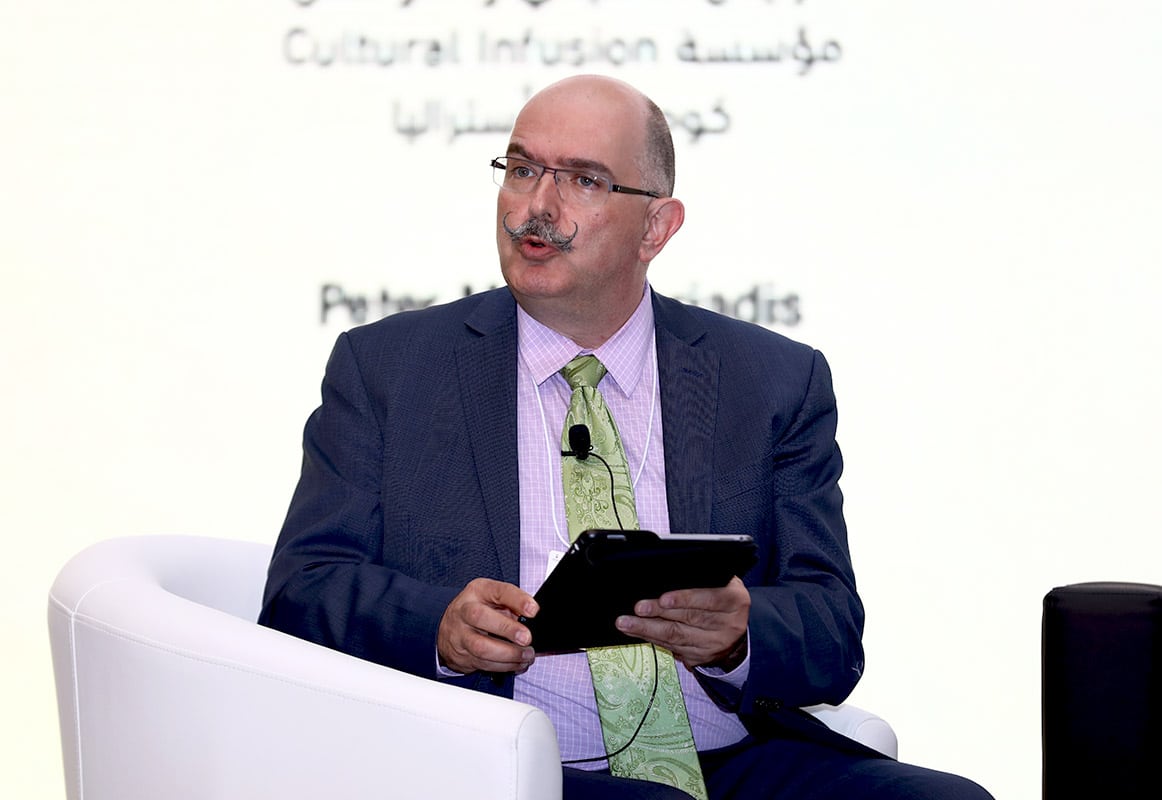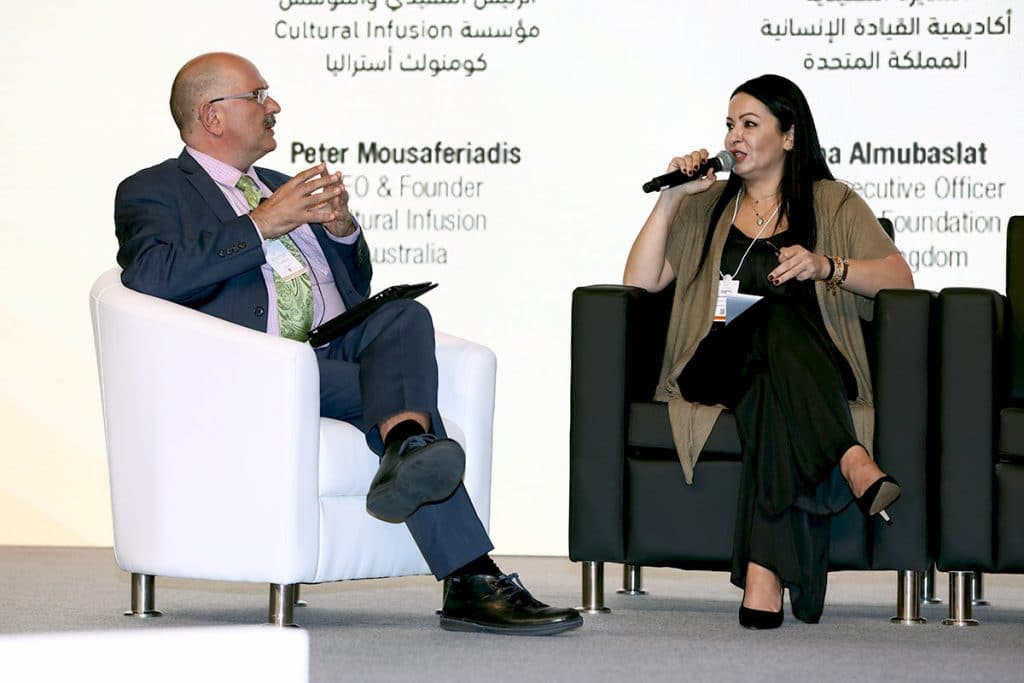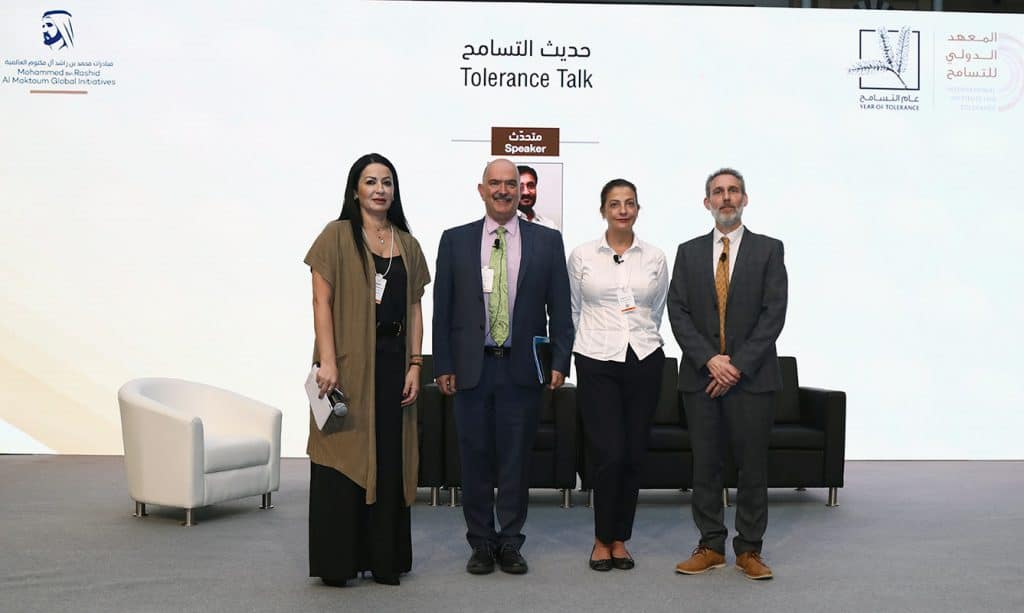
Below is an approximate transcript of Cultural Infusion founder Peter Mousaferiadis‘ opening remarks at the 2019 World Tolerance Summit in Dubai, where he was invited to moderate a panel discussion regarding the ‘culture’ pillar of tolerance.
Featured on the panel were: Saba Almubaslat (UK), CEO of the Asfari Foundation; Dawn Metcalfe (IRL), Managing Director of PDSi; and Dr Mark Owen (UK), Director of the Centre for Religion, Reconciliation and Peace at the University of Winchester.
The World Tolerance Summit 2019 brought together countries, universities, religious institutions, cultural associations, non-governmental organisations, research institutes, media, influencers, youth, and women from across the world in Dubai, United Arab Emirates on 13-14 November 2019.
Themed ‘Tolerance in Multiculturalism: Achieving the Social, Economic and Humane Benefits of a Tolerant World’, the two-day interactive summit aims to strengthen UAE’s stance to be a model for tolerance and positive coexistence, and be the catalyst to build greater understanding between cultures.
The role of culture in building tolerant societies
PETER MOUSAFERIADIS
Opening remarks at panel discussion: Tolerance Pillar – Culture (Session 1)
World Tolerance Summit, Dubai, 13 November 2019
Assalamu Alaikum.
My name is Peter Mousaferiadis and I have the honour of facilitating this panel discussion on the role that culture can play in promoting and sustaining tolerance in our societies.
“Culture is a mighty force.” It’s also a double-edged sword.
According to UNESCO, culture is:
- a driver of sustainable development;
- an eradicator of poverty;
- key to quality education, and;
- key to building peaceful, cohesive and tolerant communities – and this is why we have gathered here today.
I’d like to add that culture is also a driver of innovation. Knowledge is based on the diversification of ideas, so what better way to innovate than by bringing diverse perspectives together?
So what is culture?
Well, the term is extremely problematic and it depends on what context and what type of culture we are referring to.
Simply put, Culture is the ways in which a particular group of people live, it includes shared knowledge, values, customs and includes physical objects.
So when we hear the word Culture:
- Are we referring to the overarching culture of a nation?
- Are we referring to the ethno linguistic culture of a group or individual?
- Are we referring to organisational/workplace culture, that is, the systems, behaviours and values that an organisation’s employees are required to subscribe to?
These are all different forms of culture.
We then of course have manifestations of culture that give expression and meaning to culture. Language a living phenomenon and expresses how we think and feel. Music and the Arts play a vital role in shaping and manifesting our ideas.
Culture is also synonymous with the Arts. The connection of the Arts to culture came about when 19th century cultural theorist Matthew Arnold equated culture to refinement of the mind, and in civilizing one’s self through ‘high arts’; that is, the 18th and 19th century classical, ballet, operatic, artistic and literary traditions of Europe.
This notion of culture was developed as a way for the English to delineate themselves from all the colonies they were situated in. In a way, this manifestation still continues today in many parts of the world, in how culture and the Arts appear together as a duplex. It’s as if the Arts have hijacked the word ‘culture’ as though it were a subset to the arts, when in actual fact it is the other way around.
I personally consider this usage of culture as connected to the Arts as being problematic for two main reasons:
- Defining culture through the Arts seriously limits what can be thought of as culture.
- What is thought to be the Arts (and thus culture) is limited to European derived ideas about art and tends to exclude the Arts from other traditions.
Culture is overarching and underpinning. Every society has a culture. A way of thinking. A way of behaving. Social Norms. All these guide society. If you want to have social change then you need to change culture; in other words, social change is embedded in cultural change.
Now, a not so well-known statistic. According to UNESCO, 75% of all the conflict we have in the world has a cultural dimension. And according to the Global Peace Index, established by Australian philanthropist Steven Killelea, the cost of conflict in the world equates to almost 14% of the world’s GDP. It doesn’t take much to work out that the world is therefore spending more than 10 trillion dollars a year in dealing with conflict which has a cultural dimension. Think about that for a moment. Ten trillion dollars spent on dealing with conflict which has a cultural dimension.
So the question to all of you is, why are we not re-envisioning societies to put culture at the heart of all education, development and progress?
The lifeblood of culture is confluence. Convergence. Cultures need to be reinventing themselves. They are not there to be essentialised. In order to stay vibrant, cultures need to absorb and adapt constantly to their environment. Later, I will highlight examples of how the melding of cultures has contributed to some of humanity’s greatest achievements, and the role that tolerance has played in this.
For the purpose of today’s panel I am taking some time to unpack what we mean by culture and then frame it along with the word tolerance.

Tolerance. According the UNESCO publication ‘Defining Tolerance’, there are 7500 languages in the world and almost every single one of these languages has a different understanding of what we mean by tolerance.
In the English language, tolerance is charged with so much negativity. It has a meaning of putting up with someone even if you don’t like them. This can somewhat be attributed to Britain’s colonial history and has shaped a myriad of idioms often used in the English language: “we conquered them”, “we smashed them”, “we nailed it”, and so on. It’s all about winning, defeating the opponent. Maintaining the status quo as the dominator over the one dominated. It’s about having the upper hand.
Yes, language defines the reality we live in. It is shaped by social, political, cultural and historical factors.
In Arabic, the word tolerance is overlaid with compassion, kindness, respect and embracing the other as an equal rather than the sense of urgency in having to put up with the other.
In today’s ever increasingly globalised world where cultures meld, the ability to relate to the other has become more important than ever in building cultures of tolerance.
In the organisation I founded, Cultural Infusion, music and the Arts play an important part in building tolerance and empathy. The ability to share in the feelings of the other. All this is achieved through interactive live cultural presentations representing many parts of the world using storytelling, dance, music, and other intangible practices to create lived experiences. Our aim through our programs is to reduce ethnic and raced based discrimination, and to build intercultural understanding as a core value and key competency of what it means to be a global citizen today.
Racism is driven by fear and ignorance. The way we counteract racism is through familiarisation and collaboration with the other. This is why the lived experience becomes so important. Education is key and the arts play a vital role in creating shared meaning and understanding.
Youth across the world take a stance against injustice all the time. They are also a force for transformation. A force for good. A force for making us more tolerant.
The antonym of tolerance is intolerance. One cannot exist without the other. Nor does tolerance come naturally to humans.
At what point do we need to NOT be tolerant – where do we draw the line and say “I’m intolerant of your intolerance? In many countries, the power of music has been used as a driver to bring about transformation of political systems. In Chile, just a few days ago, soprano Ayleen Jovita Romero expressed her intolerance by defying the silence curfew imposed under martial law by the government, by singing the song ‘El derecho de vivir en paz (“The right to live in peace”) by Victor Jara.
In 2013, for the United Nations Alliance of Civilizations’ Do One Thing for Diversity Slogan competition, I coined the phrase “Divided We Fall, United We Stand, Diversified We Grow”.
When I developed this phrase I wasn’t thinking of the slogan in the context of building socially cohesive and peaceful societies, but of what diverse perspectives can bring to humanity. I was thinking of how the objective of humanity should be to find solutions towards challenges regardless of what political convictions we each hold.
History tells us again and again that societies have forever coexisted and have done so successfully. This is exemplified in architecture, language, gastronomy, sciences, maths, visual arts, language and so many other disciplines.
Think for a moment of the following:
- The numerical system, and how this came about through the convergence of Arabic, Hindu and Hellenic thought.
- The bionic eye, and how this has come about through the convergence of many disciplines coming together throughout the world. Who would’ve thought that a bionic eye could have been possible 30 years ago? We now have the early stages of bionic eye, albeit one that only provides black and white images.
None of this innovation would have been possible without intercultural dialogue. Intercultural dialogue along with tolerance become the very premise for innovation.
I have spent considerable time in Pakistan.
It wasn’t one culture that contributed to the amazing monument, the Badshahi Mosque. Arabic, Hindu, Parthian and Greek influences can be found in the building of this masterpiece.
The very first bilingual coin in the world is located in the Museum of Lahore in North Pakistan. One side is in Greek and the other side in the local language of Karosthi. What does this tell you about the values of tolerance, embracing the other, including the other?
The point I am making here is that cultures are not exclusive and need to be constantly reinventing themselves and when they come together they can create wonder.

Since the 1960s we’ve seen the rise of identity politics. The World Wide Web was developed in 1989, and in 2007 we saw the rise of social media. In a way, the latter two have fuelled identity politics, leading to the polarisation of public discourse and to the ridiculing and dehumanising of entire cultural groups. We are living in a superdiverse world where the WWW and social media has allowed for extremist thinking to be shared instantly across the globe with like-minded people.
What we are seeing is a breakdown in the vision of inclusivity and cohesion in society. Identities are divided into ‘us and them’, rather than in including everyone into the ‘we’.
One final thought that I would like to leave with you:
Several days ago I spoke with cultural theorist and author of countless publications on culture, Paul Schafer. Paul posed the question: can tolerance ever be achieved in a world obsessed with the self, with selfies and materialism – the “me” generation?
Surely it can only be achieved by focusing much more attention on the other, on others, and in sharing and caring rather than hoarding and complaining. In other words, the time is ripe for us to move out of the present economic age and into a future cultural age, where the increased intermingling of people with vastly different worldviews, values, value systems, customs, and beliefs proves to be a universal blessing rather than a diabolical curse.
In closing, I’d like to take this opportunity to thank the UAE for holding this event which is working hard to build understanding and dialogue between different countries.
Peter Mousaferiadis
Share this Post

